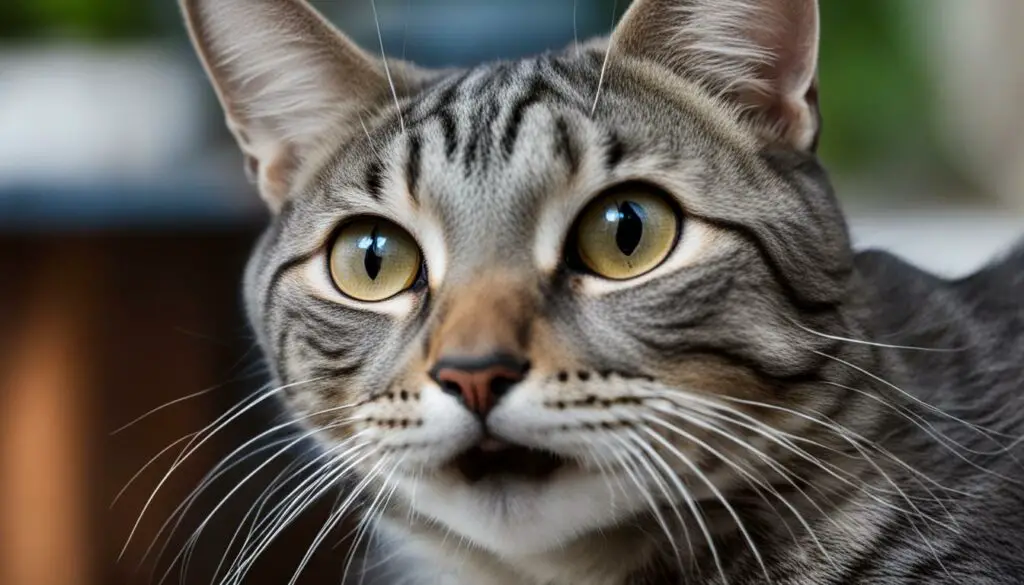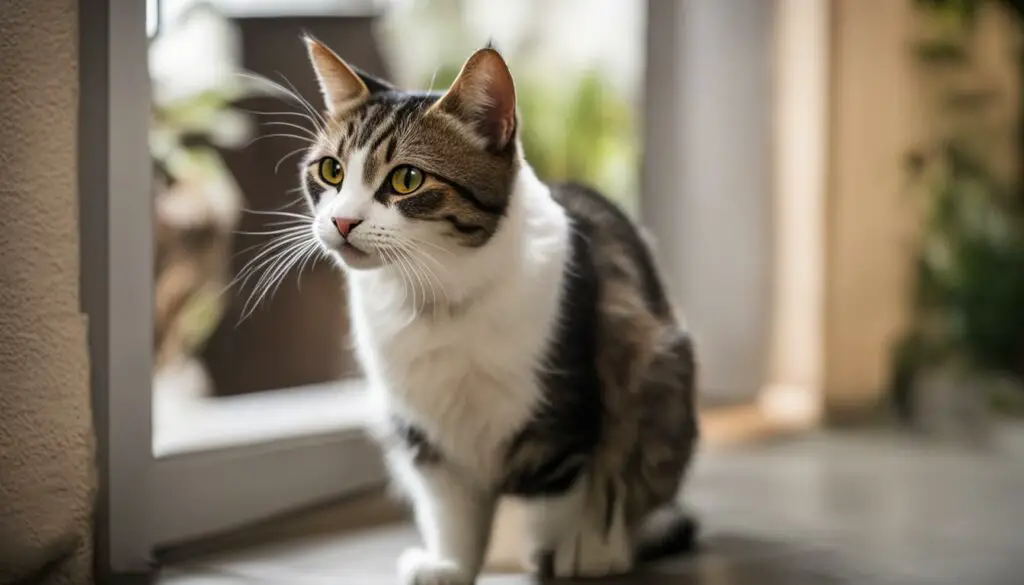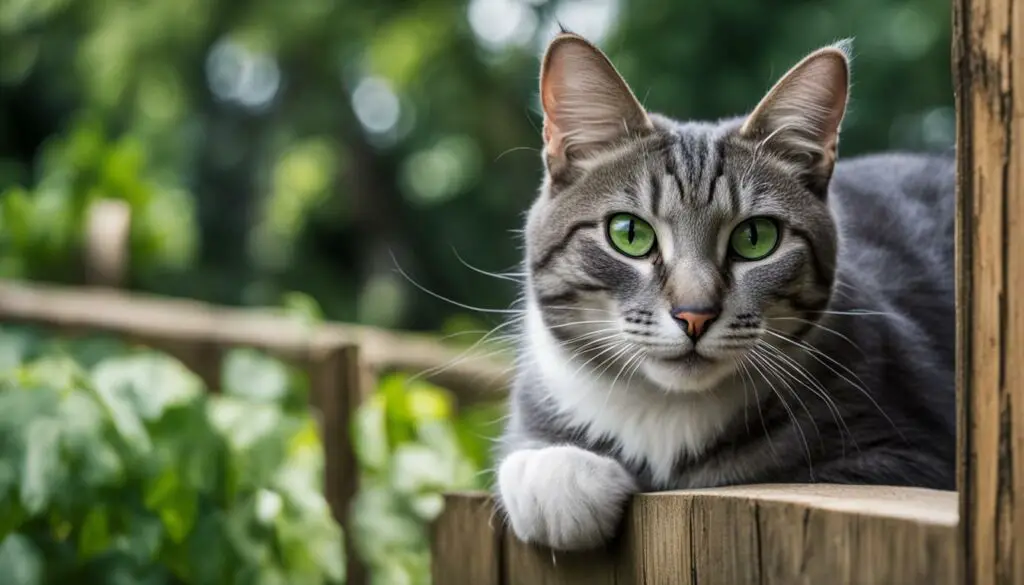Stray cats have a unique way of communicating their needs and emotions, and one of the most common ways they do this is through meowing. If you’ve ever wondered why a stray cat keeps meowing, you’re not alone. In this article, we’ll explore the top reasons behind a stray cat’s incessant meowing and how understanding their behavior can help provide them with the assistance and care they need.
Stray cat behavior can be influenced by a variety of factors, from their upbringing and experiences to their current environment. By unraveling the mysteries behind their meows, we can gain insight into their world and make a positive impact on their lives.
Key Takeaways:
- Stray cats meow to communicate their emotions, needs, and desires.
- They may meow to express hunger, loneliness, fear, or a desire for attention.
- Understanding why they meow can help provide effective assistance and care.
- Feeding, providing water, and offering shelter can help meet their basic needs.
- Establishing a bond and trust can create a path towards a safe and permanent home.
What is Cat Meowing and its Purpose
Cat meowing is a natural behavior in both domestic and stray cats. It serves as a form of communication, allowing cats to express their emotions, ask for food, attention, or seek help. When a cat meows, it is their way of vocalizing their needs and wants. Cats are known to be intelligent animals and use meowing as a means of getting their message across to humans.
Meowing can have different meanings depending on the context and the cat’s individual personality. For example, a cat might meow loudly and persistently when they are hungry, letting their human know that it’s time for a meal. On the other hand, a cat might meow softly and gently when they are seeking attention or companionship. The tone, duration, and intensity of the meow can convey a range of emotions, from excitement to frustration.
It’s important to note that stray cats may meow differently than domestic cats. Stray cats often have to communicate with humans who are unfamiliar with their behavior in the wild. As a result, they may use meowing as a way to catch our attention and convey their needs. By understanding the purpose of cat meowing, we can better respond to their communication and provide the care and support they require.

Table: Cat Meowing and its Meanings
| Meow Type | Meaning |
|---|---|
| Loud and persistent | Hunger or asking for food |
| Soft and gentle | Seeking attention or companionship |
| High-pitched and rapid | Excitement or anticipation |
| Low and growling | Anger or aggression |
| Prolonged and mournful | Distress or pain |
Understanding the various meanings of cat meowing is essential for building a strong bond with our feline companions. By learning to interpret their vocalizations, we can respond to their needs promptly and appropriately. Whether it’s offering them food, providing attention and playtime, or seeking veterinary care, our understanding of their meows can help improve their well-being and strengthen our relationship with them.
Why Do Stray Cats Meow at Humans?
Stray cats use meowing as a form of communication to interact with humans. They may meow to express their needs or to seek attention and companionship. Understanding why stray cats meow at humans can help us provide the care and assistance they require.
Reasons for Meowing:
There are several reasons why stray cats meow at humans. One common reason is hunger. Stray cats often struggle to find regular food sources, so they use their vocalizations to indicate their need for sustenance. Additionally, stray cats may meow out of loneliness, as they long for human interaction and companionship. By meowing, they are reaching out for emotional support and connection.
Seeking attention is another motive behind a stray cat’s meowing. These cats may feel ignored or neglected and use vocalizations as a way to grab our attention. They might be hoping for a kind gesture, such as a comforting touch or some playtime. By responding to their meowing, we can help fulfill their need for social interaction.
Understanding and Responding:
When a stray cat meows at you, it’s essential to approach the situation with empathy and compassion. By recognizing their meowing as a form of communication, we can better understand their needs and provide appropriate assistance. Offering food, water, or a safe shelter can address their immediate requirements, while also showing them kindness and care.
Remember, stray cats may be wary of humans due to past experiences or a lack of socialization. It’s important to approach them respectfully, allowing them to approach on their terms rather than forcing any interactions. Building trust takes time, but by responding to their meowing with patience and understanding, we can make a positive impact on their lives.

Reasons for Meowing in Stray Cats
Stray cats meow for various reasons, each signaling a specific need or emotion. Understanding these reasons is essential in providing appropriate care and support to these vulnerable creatures. Here are some common reasons why stray cats meow:
Hunger:
One of the primary reasons stray cats meow is to communicate their hunger. These cats may not have a reliable food source and rely on their vocalizations to attract attention and seek nourishment.
Loneliness:
Stray cats are social animals and often meow to express their loneliness. These cats may have been abandoned or lost their companions, leading to a sense of isolation and a desire for human contact.
Injury or Illness:
When stray cats are injured or sick, they may meow to convey their pain or discomfort. Their vocalizations serve as a plea for assistance, indicating the need for medical attention and care.
Fear or Anxiety:
Stray cats living on the streets face numerous dangers and can experience fear or anxiety. Meowing in these situations is a way for them to express their distress and seek reassurance or protection.
Seeking Shelter:
During inclement weather or harsh conditions, stray cats may meow to find shelter. Their vocalizations act as a call for refuge, indicating their need for a safe and secure place to rest.
| Reasons for Meowing in Stray Cats | Keywords |
|---|---|
| Hunger | stray cat meowing, hunger, communication |
| Loneliness | stray cat meowing, loneliness, social behavior |
| Injury or Illness | stray cat meowing, injury, illness, medical attention |
| Fear or Anxiety | stray cat meowing, fear, anxiety, distress |
| Seeking Shelter | stray cat meowing, shelter, safety, refuge |
By recognizing and addressing the underlying reasons for a stray cat’s meowing, we can provide the necessary support and improve their well-being. Whether it’s providing food, companionship, medical care, or a safe shelter, our efforts can make a significant difference in the lives of these vulnerable animals.

“Meowing is a stray cat’s way of communicating its needs to humans, and it’s important for us to listen and respond with compassion.”
How to Help a Meowing Stray Cat
When a stray cat meows at you, it is important to respond appropriately to provide the help they need. Here are some steps you can take to assist a meowing stray cat:
- Feeding: Provide the cat with food to help fulfill their basic nutritional needs. Place the food in a quiet and safe location to avoid attracting other animals.
- Providing Water: Ensure the cat has access to fresh water by placing a bowl outside. This will help keep the cat hydrated and healthy.
- Shelter: Create a sheltered area for the stray cat to seek refuge from the elements. You can use a sturdy cardboard box or purchase a cat shelter. Place blankets or straw inside for warmth.
- Naming the Cat: Giving the stray cat a name can create a bond and help build trust. Use a gentle and calm tone when calling their name.

“Providing food, water, and shelter can help meet the basic needs of a meowing stray cat.”
By taking these steps, you can contribute to the well-being of the stray cat and potentially help them find a safe and permanent home. Remember to approach the cat with caution and respect their boundaries. Building trust may take time, but your efforts can make a significant difference in the life of a meowing stray cat.
Calming Down a Meowing Stray Cat
When encountering a meowing stray cat, it’s important to understand their needs and provide reassurance to help them calm down. Here are some strategies to create a sense of calm and safety:
- Offering Food: Providing food can help the stray cat feel more at ease and build trust. Place the food in a quiet area away from any potential threats or disturbances.
- Maintaining a Safe Environment: Ensure that the environment is secure and free from any potential dangers. This includes removing hazards, such as sharp objects or chemicals, and creating a comfortable space with bedding or a shelter.
- Avoiding Sudden Movements or Gestures: Stray cats may be wary of sudden movements or gestures. To help them feel more comfortable, it’s best to move slowly and avoid any sudden or aggressive actions.
- Letting the Stray Cat Approach on Their Terms: Allow the stray cat to approach you at their own pace. Avoid forcing any interactions or physical contact, as this may cause the cat to become more fearful or agitated.
“Calming down a meowing stray cat requires understanding their needs and offering reassurance.”
By following these strategies, you can help create a sense of calm and trust for the meowing stray cat. Patience and understanding are key when working with stray cats, as each cat may have unique experiences and needs. By providing reassurance, a safe environment, and maintaining a calm demeanor, you can make a positive difference in the well-being of the stray cat.

When a Stray Cat Meows at Night
If you come across a stray cat meowing at night, it’s essential to understand the reasons behind their behavior. Stray cats may meow during the nighttime for various reasons, including mating behavior, distress, or simply seeking food.
Mating behavior is one possible explanation for a stray cat’s nighttime meowing. Cats, especially unaltered ones, tend to be most active during dawn and dusk, which is their natural mating time. Meowing loudly is a way for them to attract potential mates or establish their territory.
However, if the meowing seems distressed or prolonged, it’s important to investigate further. Stray cats may meow at night when they are in pain or facing a difficult situation. They might be injured, trapped, or struggling to find shelter. In such cases, it’s crucial to take appropriate action to ensure their safety and well-being.
| Reasons for Nighttime Meowing: | Solutions: |
|---|---|
| Mating behavior | No action needed unless it causes a disturbance |
| Distress or pain | Investigate and provide necessary assistance |
| Seeking food | Consider providing a small amount of food if the cat seems hungry |
Remember, it’s always important to approach stray cats with care and caution, especially if they are meowing at night. Observing their behavior, assessing their condition, and providing appropriate assistance can make a significant difference in their lives.
By understanding the reasons behind a stray cat’s meowing at night, we can respond with compassion and help ensure their safety and well-being.

What to Do If a Stray Cat Meows at You
If you encounter a stray cat that is meowing at you and appears friendly, there are several steps you can take to ensure its safety and well-being. Here’s what you can do:
- Catch the cat safely: Use a carrier or a towel to gently catch the stray cat. Approach with caution and avoid sudden movements that may startle the cat. Once you have safely caught the cat, you can proceed with the next steps.
- Contact an animal shelter or a vet: Take the stray cat to a local animal shelter or a vet to check for a microchip. This can help identify if the cat has an owner who may be looking for them. If no microchip is found, the shelter or vet can provide necessary care and guidance on what to do next.
- Consider long-term care: If you are unable to locate the owner or if the cat is in need of ongoing care, you can consider providing long-term care for the stray cat. This may involve finding a suitable foster home or seeking assistance from a rescue organization that specializes in stray cat adoption.
Remember, safety is important when dealing with stray cats. If you are unable to safely catch the cat or if you have concerns about your own safety, it is recommended to contact your local animal control for assistance and guidance.
By taking these steps, you can help ensure that a meowing stray cat receives the necessary care, whether that be reuniting them with their owner or finding them a safe and loving forever home.

Further Resources:
If you’d like to learn more about how to help stray cats and provide them with the care they need, here are some additional resources you may find helpful:
“Understanding Stray Cat Behavior: A Guide to Helping Abandoned Felines.” Available at: www.example.com/guide-to-stray-cats
With the information provided in this section and the resources available, you will be well-equipped to handle a meowing stray cat and make a positive difference in its life.
Ignoring a Meowing Stray Cat
Deciding whether to ignore a meowing stray cat depends on various factors. If the cat seems healthy and is simply looking for food, providing a small amount may be considered. However, feeding stray cats can attract more of them to the area. It is important to take into account safety concerns and the potential impact on the local environment before deciding to feed a stray cat.
| Deterrence Methods | Effectiveness |
|---|---|
| 1. Spraying Water: Using a spray bottle to spritz water towards the cat when it approaches your property. | Can be effective in deterring stray cats from coming near your house, as they generally dislike getting wet. |
| 2. Making Loud Noises: Clapping hands, banging pots, or using other loud noises to startle the cat. | Can temporarily scare away stray cats, but may not be a long-term solution as they can become accustomed to the noise. |
| 3. Motion-Activated Devices: Installing motion-activated sprinklers or ultrasonic devices that emit high-frequency sounds to deter cats. | Can be effective in keeping stray cats away from specific areas, but may not deter them completely. |
Using deterrence methods can help discourage stray cats from frequenting your property without causing harm. It is essential to prioritize the safety of both yourself and the cat when implementing these methods. Remember to never physically harm or intentionally cause distress to a stray cat.
If you choose to ignore a meowing stray cat, ensure that you are consistent in not providing food or other forms of encouragement. The cat may eventually learn that your property does not offer the resources it seeks, and may move on to other locations.
When a Stray Cat Comes to Your House
It can be both surprising and heartwarming when a stray cat comes to your house. This unexpected visitor may be in search of food, shelter, or even companionship. Understanding how to respond to this situation can help ensure the safety and well-being of the cat, as well as your own.
Firstly, it is important to assess the behavior and condition of the stray cat. If the cat appears friendly and approachable, you may consider providing it with some food and water. This act of kindness can help meet its immediate needs and establish a sense of trust. Additionally, if the cat seems open to human interaction, you can try to provide temporary shelter, such as a comfortable box or a blanket in a quiet area of your yard or porch.
If you come across a stray cat that seems lost or in distress, it is essential to take further action. Contacting a local rescue organization or animal shelter can provide guidance on how to proceed. They can assist in scanning the cat for a microchip in order to locate its owner, as well as provide necessary medical care and socialization. If you are unable to safely catch the cat or have concerns about your own safety, reaching out to local animal control may be a viable option.
| What to Do When a Stray Cat Comes to Your House | What Not to Do When a Stray Cat Comes to Your House |
|---|---|
|
|
Remember, when a stray cat comes to your house, it is crucial to approach the situation with care and compassion. By providing temporary assistance, seeking professional guidance, and ensuring the safety of both the cat and yourself, you can make a positive impact on a stray cat’s life and potentially help them find a permanent and loving home.
Why Stray Cats Meow at Night
Stray cats often meow at night due to their natural activity patterns and mating behavior. Cats, whether domesticated or stray, are most active during dawn and dusk, which is known as their crepuscular activity period. During this time, they are more likely to vocalize, including meowing, as a way to communicate with other cats and potential mates. This behavior is particularly common in unaltered stray cats, as they are driven by their instinctual desire to reproduce.
Meowing at night is also a form of communication for stray cats to establish their territory and mark their presence. By vocalizing, they are signaling to other cats to stay away from their area. This territorial behavior is more prevalent in male stray cats, who may engage in loud meowing to ward off other males and attract receptive females.
Additionally, meowing at night can also be influenced by external factors such as hunger or distress. Stray cats may meow more frequently if they are in need of food or if they are experiencing discomfort or fear. It is essential to assess the overall condition of the cat and ensure its well-being, especially if the meowing seems distressed or prolonged.
Signs a Stray Cat Likes You
If you’ve been caring for a stray cat and wondering if it has developed a liking towards you, there are several signs to look out for. Stray cats may show their trust and closeness through their behavior, indicating a level of comfort and acceptance.
One of the signs that a stray cat likes you is when it comes close to you. It may approach you cautiously at first, but over time, it may become more comfortable and even seek out your presence.
Another sign is when the stray cat starts following you. If you notice that the cat tends to trail behind you or even shadow your movements, it could be a sign that it sees you as a source of safety and security.
“The more a stray cat seeks closeness and proximity to you, the more likely it is that it has developed a liking towards you.”
In addition, a stray cat may display signs of affection by rubbing against you. This behavior is a way for the cat to mark you with its scent, indicating that you are seen as part of its territory and trusted companion.
Finally, some stray cats may bring “gifts” to show their appreciation. These “gifts” often come in the form of dead prey, such as small rodents or birds. While it may seem unusual, this behavior stems from the cat’s instinct to provide food and contribute to the group.
| Signs a Stray Cat Likes You |
|---|
| Coming close to you |
| Following you |
| Rubbing against you |
| Bringing “gifts” |
Conclusion
Understanding why a stray cat keeps meowing is crucial in providing the necessary assistance and care. Stray cats meow as a way to communicate their needs, whether it’s hunger, companionship, fear, or a cry for help. By recognizing and responding to their meowing with compassion and empathy, we can make a positive impact on their lives.
Assisting a stray cat involves more than just providing food and water. It requires a deep understanding of their behavior and the ability to offer a safe and secure environment. Showing kindness and patience towards these vulnerable animals can help build trust and establish a connection.
When encountering a meowing stray cat, it is essential to approach them with care and take the necessary steps to ensure their well-being. This may involve contacting local animal shelters or rescue organizations for assistance. Remember, every act of compassion towards a stray cat contributes to their overall welfare and reminds us of the power of empathy and care.
FAQ
Why does a stray cat keep meowing?
Stray cats meow for a variety of reasons, including hunger, loneliness, injury, fear, or a desire for shelter. Meowing is their way of communicating their needs and seeking assistance from humans.
What is cat meowing and its purpose?
Cat meowing is a form of communication used to express emotions, ask for food, water, attention, or seek help. It is their way of letting humans know what they need or want.
Why do stray cats meow at humans?
Stray cats meow at humans as a form of communication. They may meow to indicate hunger, loneliness, or to seek attention from humans. It is their way of expressing their needs and trying to establish a connection with people for food, water, or companionship.
What are the reasons for meowing in stray cats?
Stray cats meow for various reasons, including hunger, loneliness, injury, fear, or a desire for shelter. Meowing is their way of communicating their needs and seeking assistance from humans.
How can I help a meowing stray cat?
Providing food, water, and shelter can help meet the basic needs of a meowing stray cat. Naming the cat and establishing a bond can also create a sense of trust. These steps can contribute to the well-being of the stray cat and potentially lead to a safe and permanent home.
How can I calm down a meowing stray cat?
Calming down a meowing stray cat requires understanding their needs and offering reassurance. Providing food, maintaining a safe environment, and avoiding sudden movements or gestures can help create a sense of calm and trust. It is important to let the stray cat approach on its own terms and not force any interactions.
Why do stray cats meow at night?
Stray cats meow at night primarily due to their natural activity pattern and mating behavior. Cats are most active during dawn and dusk, and this is when they are more likely to vocalize. Meowing at night can also be a way for stray cats to communicate with other cats and seek potential mates or territory.
What should I do if a stray cat meows at me?
If a stray cat meows at you and appears friendly, you can try to catch it safely using a carrier or a towel. Taking the cat to an animal shelter or a vet to check for a microchip can help locate the owner or provide necessary care. If unable to catch the cat or concerned about safety, contacting local animal control can be a viable option.
Should I ignore a meowing stray cat?
Deciding whether to ignore a meowing stray cat depends on various factors. If the cat seems healthy and is simply looking for food, providing a small amount may be considered. However, feeding stray cats can attract more of them to the area. If not comfortable with having stray cats around, deterring methods such as spraying water or making loud noises can be effective. Safety should always be a priority.
What should I do when a stray cat comes to my house?
When a stray cat comes to your house, it could mean that the cat is lost and seeking food or shelter. Assessing the cat’s behavior and condition is important to determine the best course of action. Consulting with a rescue organization can provide guidance on how to proceed and ensure the safety and well-being of both the cat and yourself.
Why do stray cats meow at night?
Stray cats meow at night primarily due to their natural activity pattern and mating behavior. Cats are most active during dawn and dusk, and this is when they are more likely to vocalize. Meowing at night can also be a way for stray cats to communicate with other cats and seek potential mates or territory.
What are the signs that a stray cat likes you?
Stray cats may show signs of liking or trusting you through behavior such as coming close, following you, rubbing against you, or bringing “gifts” like dead prey. These behaviors indicate a level of comfort and acceptance, which can be a positive sign if considering adopting or providing long-term care for the stray cat.
How can I understand and provide care for a stray cat that keeps meowing?
Understanding why a stray cat keeps meowing is key to providing effective help and care. Stray cats meow for various reasons, including hunger, companionship, fear, or seeking assistance. By responding appropriately and with compassion, we can make a positive difference in the lives of stray cats and contribute to their well-being.








